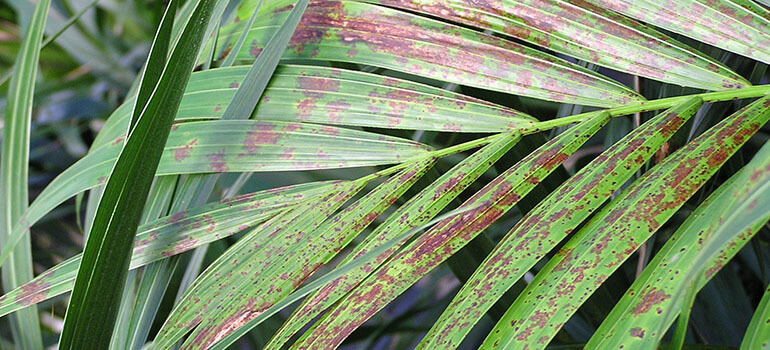For generations, gardening has been a popular pastime in the UK. Regardless of whether it is an ornamental or vegetable garden, the act of sculpting the land around us to create our very own oasis of tranquillity provides a sense of comforting accomplishment. It is also a great way to express creativity and individuality.
However, gardeners across the country must remain vigilant as many threats seek to destroy our hard work. These forces of gardening darkness come in the form of pests and diseases. We have written about garden pests and how to deal with them before, so be sure to check our blog if slugs are feasting on your garden.
It is now time to focus on diseases, specifically box blight. This guide will supply you with all the knowledge you need regarding what’s causing it, how to identify and properly treat this common garden disease.
Table of Contents
What is box blight?
Box blight is a disease which affects Boxwood (Buxus sempervirens) and its family of plants.
The disease is caused by two genetic types of fungi, Cylindrocladium buxicola and Volutella buxi, that attack the leaves and stems of the plant. Thankfully, it does not affect or kill the roots so, with the right box blight treatment, you don’t have to replace the entire plant.
What are box blight symptoms?
Both of these disease-inducing fungi display easy-to-spot symptoms such as:
- Brown areas on the infected plants
- Dry, yellow leaves which look close to shedding (pink dots are also among the first signs of the disease)
- Dark-coloured bare stems
- White or grey fungus growing on the affected areas
It is a good idea to check your plants regularly and treat any affected areas as early as possible as box blight becomes increasingly difficult to deal with as time passes.
What does box blight look like?
Now let’s see how you can best identify the box blight. After all, the displayed symptoms depend on which fungus your plants are infected by. We’ll look into each one individually.

Cylindrocladium buxicola – In the early stages of the disease, the plants will have patchy areas of brown, withered leaves and, as it progresses, the affected areas will lose their leaves.
Other signs of infection to look for are black-striped, or entirely blackened stems and a slender grey fungus on the underside of leaves.

Author: SB_Johnny, licenced under CC-BY-3.0
Volutella buxi – Plants affected by this fungus will show areas of yellowed leaves, with pink spots underneath during the early stages. These leaves will also fall later on.
How to get rid of box blight once and for all
Box blight hedge treatment could be a long and difficult process. The more advanced the infection is, the lower the chances of reversing its effect. However, with patience and dedication, it can be done successfully.
Still, we need to point out that in cases when the disease is too widespread, it may be best to destroy the infected plant and invest your time and effort in cultivating a healthy replacement instead.
Before we look into the box blight treatment strategies, there are protective measures you should take to reduce the chances of the infection spreading.
Now that we’re ready, let’s move on to the box blight cure.
Method 1: Cut out all infected parts
Since box blight attacks the leaves and stems of plants, the first task is removing the infected areas to stop the disease from spreading.
It is vital that you do this during a dry period. If you prune the infected areas while the plant is wet or there is rain forecast, the disease will spread rapidly. Knowing how much of a plant to remove can be tricky in a lot of situations but, with box blight, there are three straightforward options. Which option you choose depends on the severity of the infection.
- Clear out only the affected plant parts (infection in the making) – If you have noticed the infection during the early stages, this is the option for you. Simply cut the infected stems back until they are brown on the outside and vivid green beneath the bark. Once you reach the healthy parts of the plant, cut it back a little bit more.
- Reduce plant height (advanced infection) – When faced with a large-scale infection, the best course of action is to reduce the height of the plant by half, or until there are no blackened stems.
- Prune everything to the stump (severe infection) – If the infection is too severe and you don’t want to replace the plant, the only option is to cut the entire plant down until it is just a stump.
Regardless of which option you choose, when you’re finished pruning, spraying the remainder of the plant with a fungicide to kill off any lingering spores is a good idea. Here it’s important to note, though, that relying solely on sprays for box blight control, whether specialised chemical ones or homemade natural ones, will be insufficient and at best will only slow down the spreading of the disease.
As to what fungicides you can apply in addition to the trimming, there are some specialised box blight commercial treatments available, as well as various broad-spectrum fungicides.
Whichever you decide to use, read the label instructions carefully. They should provide you with valuable information on how to apply the product, as well as when and under what conditions to guarantee success. These fungicides can come in handy if the affected areas are too small to prune.
Method 2: Clean up your garden
Good garden maintenance is important for reducing the risk of all kinds of diseases and pest infestations in the long run. So there are a few simple things you could do to keep your garden tidy and healthy.
Remove any severed stems or leaves that are trapped inside the plant
The dead leaves around the base of the plant provide a perfect breeding ground for fungi, so clear away all of the leaves under and around the plant.
Be meticulous as it doesn’t take many leaves to restart the infection. Spores from either type of fungi are capable of surviving in the soil for an astoundingly long time. Because of this, you will have to remove and replace a layer of soil from around and under the plant.
Disposal of infectious materials
Once you’ve collected all of the infected plant cuttings and leaves, you’ll need to get rid of them. The best method of disposal is to burn all of the cuttings but, if you are unable to burn them, you can seal them in a bag and put it in the bin.
You should avoid adding any of the infected plant parts to your compost heap or the council recycling composting bin under any circumstances. This will only spread the fungus spores over a wider area.
And don’t forget to clean your tools, too.
How to prevent box blight in the future
After all of that hard work you did treating the blight, the last thing you want is for it to come back. The tips below will greatly decrease the chances of a box blight resurgence.
- The garden and its layout. To create the warm, breezy environment your boxwood plants can thrive in, make sure no other plants are growing within a radius of one foot. Also, keep any overhanging plants cut back as much as possible.
- Spray healthy plants with fungicides – While fungicides are not enough to stop a spreading box blight disease, they can help prevent an infection for healthy plants. You can apply it on the latter prophylactically to keep them in good shape.
- Plant food. Using fertiliser in the spring will aid the plant’s post-winter recovery, but try not to use fertilisers with high concentrations of nitrogen. This can over-stimulate the growth of the plant and create the conditions for box blight to reappear.
- Water the base of the plant, not the overhead.
- Monitor your plants. Box blight can be a stubborn infection, so don’t be surprised if the infection flares up again after the first treatment. Check the recovering plant at least once a week so that you can quickly identify and treat any new signs of infection.
- Keep the ground under and around the plant clear of fallen leaves. Maintaining a tidy garden not only looks good, but will help prevent future box blight outbreaks.
Box blight-resistant alternatives to boxwood
If these box hedge problems are too much to deal with, or you don’t have the time to treat and monitor a hedge, there are box blight-resistant alternatives.
The following are excellent choices for replacing boxwood that are just as easy to style and can be visually stunning.
- Golden barberry (Corallina compacta);
- Japanese holly “Golden gem” (Ilex crenata);
- Wilson’s honeysuckle (Lonicera nitida).
So, there we have it, your guide on how to identify and treat box blight. With this information, you are now ready to decide whether to rip out and replace the humble boxwood or tenderly nurture affected plants back to good health.
Need professional assistance in the garden?
Enter your postcode to view our rates and availability in your area.
For questions about the services we offer visit our main site or you can always call us at 020 3404 4881
***
Did we miss anything? Do you have any tips for dealing with box blight? Let us know in the comments below or give us a shout on social media!
Image source: Shutterstock / Yuriy Biryukov






Great tips here, like you say this pesky disease can change the aesthetic of even the most beautiful outdoor space. There are many varieties of Ilex crenata to choose from should you stray from boxwood hedging so there are always easier options available.
Definitely, Tabitha, boxwood hedging is a classic but if the problem is persistent, you can always opt out.
I have discovered box blight on my box plants I have cut down the most affected plants and reduced the rest down to one to third/ quarter. And sprayed using propriety recommended spray. However just noted that your site recommends burning or bagging. And so now will remove debris from my garden bin and bag up. How do I dispose of the bags. Caterpillars and are migrating out of the bin. Need some help!!
Hey Mrs Jones, there’s lots of garden waste removal companies that may be willing to take up some of the initial amount for free – you can check them out! We also offer such a service, so let us know!
Great suggested options to replace the infected boxwood.
My question is, what needs to be done to the soil the boxwood occupies in order to plant something in its place?
I have this same question!
In the early spring of this year, my front garden box hedge caught the disease, with all the leaves turning brown & the plants looking quite dead. I didn’t remove the plants, so imagine my surprise when, in early summer, I spotted new leaves starting to emerge, and not just near the base, but all over the plant. It’s early days & the disease could strike again, but I’ll be ready for it with my spray to give it a fighting chance.
Good luck! Let us know how it went through!
I had blight on two bushes. I really thought that I had lost them totally. So trying anything could not make it worse.
The solution is to spray it with white vinegar diluted with water. I used 1 part vinegar to 2 parts water.
Both of my bushes now look beautiful . Good luck with yours
How often did you treat the Bushes.Did you prune before the treatment.If more than once how long between
treatments.
Chris
I have onion white vinegar..is this ok to use?
Hi
How often did you spray the blight with vinegar?
Lorna
I have boxwood blight in my boxwood what fungiside should I use? Thanks
Thanks RHS for your help but you do suggest burning (which I can’t do) or bagging up and containing the disease but never take it to the recycling centre so where should I dispose of it?. Thanks
gardrening is watering hoseing seeding
I to have had box blight in my garden where l have many small hedges, l sprayed last year with the white vinager and water, with success, but it is back this year with gusto, should l cut. It back as well?
Very useful tips but you dont say much abo9ut treatment – If I am spraying against Box Blight does it matter at what time of year? I have found some products say ‘”for use between March-Sept” I have a very extensive area to treat.
Thanks
My neighbour over the road lost all his box last year. When he told me I checked mine and the first four on one end were infected. At that time I wanted to act fast and did not know what the cause of the blight was so sprayed repeatedly with my rose spray (for aphids & fungus). It seems to have worked. This spring they have new leaves but I will contunue to spray.
I also like the idea of vinager as this worked when I had fungus under my toe nails!
I have white sticky like dust all over my box hedge. The leaves are curling on the new growth. When my dog goes near his covered in sticky stuff. What is it.